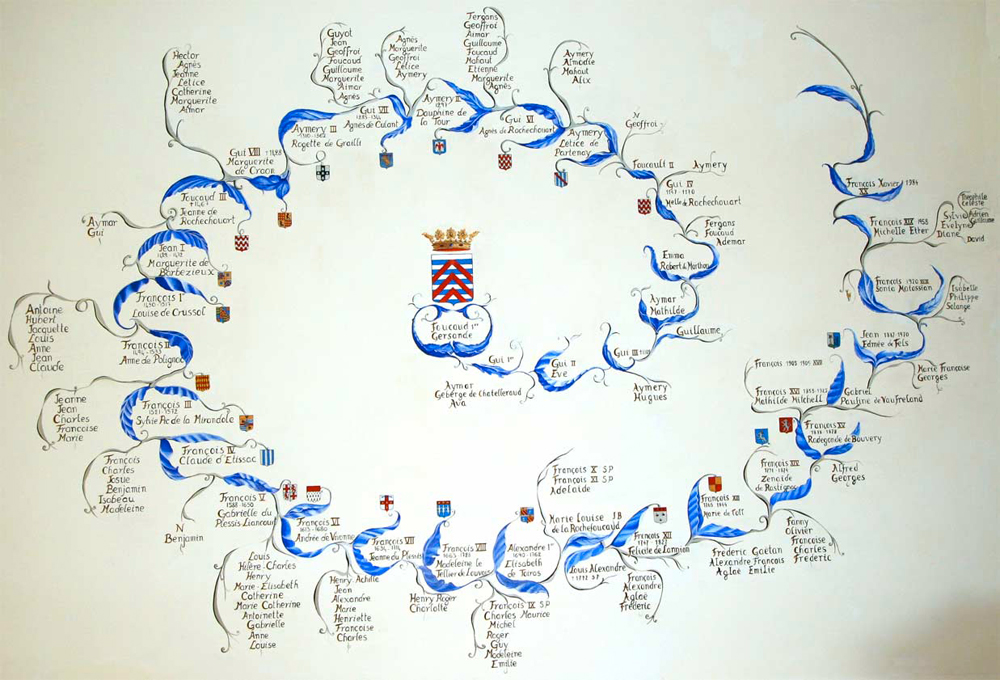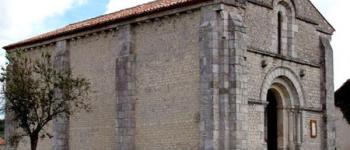
Through the diversity, quality and elegance of its architecture, the Château de La Rochefoucauld is rightly considered one of the most remarkable in France.
The building is surrounded by tall round towers, the oldest of which form the châtelet that defends the old drawbridge. The others, dating from the 15th century, are crowned with machicolations and topped with particularly sharp attics.
A little history
The history of the castle is inseparable from the history of the La Rochefoucauld family, which, century after century, is part of the political life of its time. The castle of La Rochefoucauld remarkably illustrates the intertwining of politics and architecture through the life of a family that has owned the castle without interruption since Fucaldus laid the first fortification around 980.
In 980, Fucaldus, younger brother of the Count of Limoges, built a fortified camp on the rock overlooking the river and called it "Fucaldus in rupe", "La Roche à Foucauld". Then Fucaldus' son had the square keep built before, in 1350, Aimery de La Rochefoucauld had the two entrance towers built.
In 1453, Jean de La Rochefoucauld erected the three corner towers and raised the keep following the victory of the battle of Castillon which ended the Hundred Years' War.
The de La Rochefoucauld family has distinguished itself, century after century, by remarkable personalities. Cardinal François de La Rochefoucauld, great chaplain of France, presided over the King's Council under Louis XIII.
François VI, an opponent of Richelieu, became the head of the Fronde des Princes, before becoming one of the greatest writers of his time, author in 1664 of the famous "Maximes".
La Rochefoucauld d'Anville, a member of the Academy of Sciences, an admirer of the American Constitution and Franklin's personal friend, led the liberal movement of the nobility during the 1789 States General. He died massacred in Gisors in September 1792, a few days after his cousins from La Rochefoucauld-Bayers, bishops, clergy deputies at the Estates General, executed at the prison of the Carmelites and beatified.
Finally, François-Alexandre de La Rochefoucauld-Liancourt (1747-1827), a member of the nobility at the time of the Estates General, emigrated to the United States at the darkest hours, was at the origin of the School of Arts and Crafts, then also co-founded the Caisse d'Epargne.
A magnificent castle
"In this castle, the visitor will see his eye drawn to the decor of the courtyard and in particular the astonishing decoration of an Italian "cortile", lined with porticoes with arches on three levels.
Also worth seeing are the magnificent doors that open on all the floors of the galleries, reflecting the strong taste of the Italian Renaissance for antiquity.
One of the most remarkable doors is that of the Chapel, framed by two fluted columns surmounted by Corinthian capitals with the "F" and "A" for François and Anne. The door is a low arch door and cherubs decorate the arch. Above it is a motif called a running dog, typically Florentine
The Chapel also deserves some attention. Its apse fills the great tower, pierced on this occasion by high windows in third points, vaulted with warheads on columns very inspired by Italian art. For the first time perhaps in France, they carry entablature sections above their capitals, a convenient arrangement to give the support more elevation while preserving the ancient proportions of the column. In the 20th century, the sudden death of little François XVII significantly altered the interior appearance of the chapel, with his parents replacing the stained glass windows, setting up a gallery, tiling the choir and displaying his initials and young face everywhere. Francis XVII and his parents are buried in the chapel.
The main part of the castle is the grand staircase. A traditional spiral staircase with a powerful twisted core, decorated with panels with geometric mouldings that remind us of both Blois and Chambord, this spiral staircase is set in a square of 6.75 metres on each side and ends with a palm tree of warheads. In the centre, a bust holding a falcon in his hands with a madman's collar adorned with bells around his shoulders remains a mystery as to his identity. The staircase has 108 steps, the longest being four metres.
Furniture and paintings
The castle offers visitors around twenty furnished rooms, including seven lounges. The paintings, furniture and objects that decorate the rooms of the castle come from the family collections.
Most of the paintings represent the members of the family and date from the 17th, 18th and 19th centuries: François VI, author of the sentences and maxims, Louis-Alexandre, murdered in Gisors in 1792, François XII, founder of the School of Arts and Crafts, introducer of the vaccine in France, co-founder of the Caisse d'Epargne.
Libraries, archives, maps and prints
The castle houses very important libraries. In addition to the 18,000 volumes carefully preserved, there is a collection of about 300 cards or prints and about ten metres of archival shelves.
Dating for a very large part from the 18th century, a little from the first half of the 19th century and to a lesser extent from earlier periods, the works are almost entirely covered with period binding and are in good condition.
History, political economy, science, travel, genealogy, scholarship and law constitute the main collection of this library.
The whole is of exceptional interest for the quality of the texts, the meeting of which makes a remarkable contribution to the history of ideas.
A fairly large number of volumes are struck with the arms of the La Rochefoucauld and a large part contains an ex-libris in the name of the family.
The treasure of the charters, located on the first floor of the castle, contains several thousand pieces of archives and covers eight centuries of history, from the 13th century to the present day.
It contains documents mainly from the Château de Montmirail in the Marne, but also from those of La Roche-Guyon in the Val d'Oise, Liancourt in the Oise, Verteuil and La Rochefoucauld in the Charente.
In each of these properties, the La Rochefoucauld had an archive, which was called, under the Ancien Régime, a "treasure of charters" which was not lost despite successive divisions and the Revolution.
In addition to its very large collection of books, the castle also has some three hundred maps and prints representing views of cities, countries or continents as well as battle plans.
From February 15 to January 1, 2025, the château is open every day except Tuesday from 10:00 to 19:00.
Castle of La Rochefoucauld
16,110 La Rochefoucauld
Tel: 05 45 45 62 07 42
amis-du-chateau@wanadoo.fr
http://www.chateau-la-rochefoucauld.com/

Vous souhaitez acheter le livre Pierre de La Tardoire. Le Château de La Rochefoucauld. ?

Vous souhaitez acheter le livre Les plus beaux châteaux du Sud-Ouest ?





